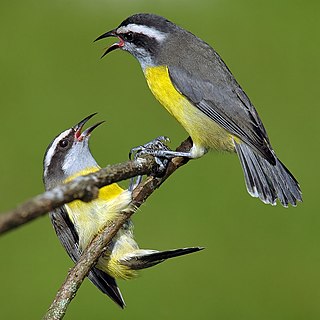
The bananaquit is a species of passerine bird in the tanager family Thraupidae. Before the development of molecular genetics in the 21st century, its relationship to other species was uncertain and it was either placed with the buntings and New World sparrows in the family Emberizidae, with New World warblers in the family Parulidae or its own monotypic family Coerebidae. This small, active nectarivore is found in warmer parts of the Americas and is generally common.

The grey-fronted dove is a large New World tropical dove. It is found on Trinidad and in every mainland South American country except Chile.
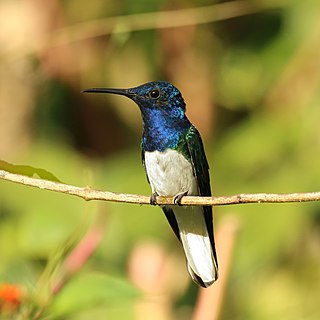
The white-necked jacobin is a medium-size hummingbird that ranges from Mexico south through Central America and northern South America into Brazil, Peru and Bolivia. It is also found in Trinidad & Tobago.

The ruddy ground dove is a small New World tropical dove. It is a resident breeder from Mexico south to Brazil, Peru and Paraguay, and northern Argentina, and on Trinidad and Tobago. Individual birds can sometimes be seen in the southwestern USA, from southern Texas to southernmost California, primarily during winter.

The pale-vented pigeon is a large pigeon found in the tropical Americas. Formerly often placed in Columba, it actually belongs to a clade of the older New World genus Patagioenas. With its relatives it represents an evolutionary radiation extending through most of the warm-temperate to tropical Americas. Grey-hued birds, even their males generally lack iridescent display plumage, although the present species has some coppery gloss on the nape.

The grey-headed dove (Leptotila plumbeiceps) is a large New World dove. It is found from eastern Mexico to Colombia.

The Grenada dove is a medium-sized New World tropical dove. It is endemic to the island of Grenada in the Lesser Antilles. Originally known as the pea dove or Well's dove, it is the national bird of Grenada. It is considered to be one of the most critically endangered doves in the world.

The silvery pigeon, also known as silvery wood-pigeon or grey wood-pigeon, is a species of pigeon found in Indonesia and Malaysia. It was thought to be extinct but wild populations rediscovered in 2008 near Masokut Island of the Mentawai archipelago might represent this species, and photographs from Simeulue confirm its existence there.

The black curassow, also known as the smooth-billed curassow and the crested curassow, is a species of bird in the family Cracidae, the chachalacas, guans, and curassows. It is found in humid forests in northern South America in Colombia, Venezuela, the Guianas including Suriname, and far northern Brazil, and is introduced to Bahamas, Cuba, Jamaica, Haiti, Dominican Republic, Puerto Rico and Lesser Antilles. It is the only Crax curassow where the male and female cannot be separated by plumage, as both are essentially black with a white crissum, and have a yellow or orange-red cere.

The brown-throated parakeet, also known as the St. Thomas conure or brown-throated conure in aviculture, is a species of bird in the subfamily Arinae of the family Psittacidae, the African and New World parrots. It is found in Costa Rica, Panama, the northern mainland of South America, and islands off the South American coast.
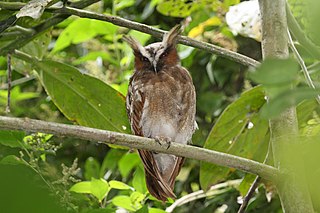
The crested owl is a species of owl in the family Strigidae. It is the only species (monotypic) in the genus Lophostrix. It is a resident bird and occurs in Central America and northern South America. It is a medium-sized owl, easily recognizable with its very long whitish ear tufts and otherwise darker appearance. It inhabits lowland rainforests and prefers old growth in proximity with water. The crested owl is a strictly nocturnal species, but very little is known about its behaviour.

The Azuero dove or brown-backed dove is a species of bird in the family Columbidae. It is endemic to Panama.

Leptotila is a genus of birds in the dove and pigeon family Columbidae. These are ground-foraging doves that live in the Americas.
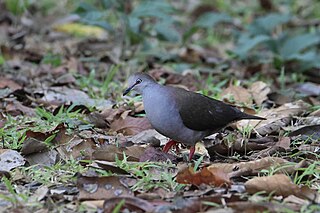
The grey-chested dove is a species of bird in the family Columbidae. It is found in Belize, Colombia, Costa Rica, Guatemala, Honduras, Mexico, Nicaragua, and Panama.

The Caribbean dove is a species of bird in the family Columbidae. It is found in Belize, the Cayman Islands, Colombia, Honduras, Jamaica, and Mexico. It has been introduced to the Bahamas.
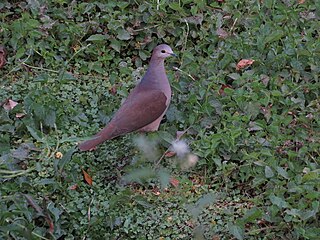
The Yungas dove, also known as the white-faced dove or large-tailed dove, is a species of bird in the family Columbidae. It is found in Argentina and Bolivia.
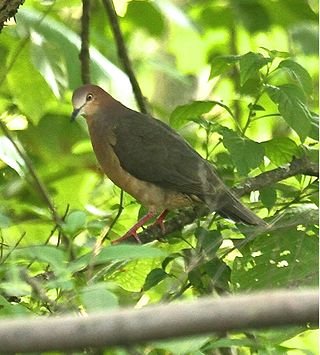
The ochre-bellied dove or buff-bellied dove is a species of bird in the family Columbidae. It is found in Ecuador and Peru.

The pallid dove is a species of bird in the family Columbidae. It is found in Colombia, Ecuador, and Peru.

The mangrove vireo is a species of bird in the family Vireonidae.
























